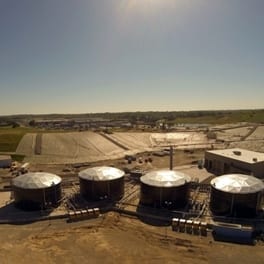Landfill juice. Garbage water. Leachate. Whatever you call it, it can be a problem for landfill operators. Managing leachate can be as high as 30% of a landfill’s operating costs. Before a treatment method can be determined, it’s important to first understand your leachate.
The types of waste accepted at a landfill, as well as the age of the cells producing leachate, will contribute to the properties of the leachate. Early in a landfill decomposition, leachate will have a lower pH and high biochemical oxygen demand (BOD), total organic carbon (TOC) and chemical oxygen demand (COD). As the landfill ages, the pH neutralises and the BOD, TOC and COD lowers. The pH of the leachate depends not only on the concentration of the acids present, but also on the partial pressure of the CO2 in the landfill gas that is in contact with the leachate. Leachate biodegradability The biodegradability of the leachate will also vary with time. In young landfill cells the BOD/COD is about 0.5 and organic matter in leachate is readily biodegradable. In mature landfills, the BOD/COD lowers to the 0.05 to 0.2 range, because the leachate in mature cells typically contains humic and fulvic acids which are not readily biodegradable. Various types of wastes accepted at a landfill also contribute to the chemical and biological properties in leachate. Some examples of different waste streams and their effects include:- Construction and demolition (C&D) waste – tends to cause high concentrations of total dissolved solids in the leachate. Primary contributions to the dissolved solids are sulphate and calcium, predominantly from gypsum drywall. Concrete in C&D landfills causes high leachate pH, often as high as 11;
- Industrial waste can contain any number of toxins, heavy metals or pharmaceuticals that will affect leachate quality and require treatment to some degree;
- Leachate from exploration and production (E&P) waste from the drilling and fracking industry can possess high concentrations of total dissolved solids (TDS), chlorides, and sulphates and moderate concentrations of toxic heavy metals. E&P waste can also contain naturally occurring radioactive material which can be present in the leachate;
Landfill design
Because of wide variations in leachate characteristics, even from a single landfill, design of treatment is not a one-solution-fits-all scenario. Some leachate may require multiple technologies to address all the constituents of concern. Source: ET Environmental Special thanks to Amy Dill, PE, Design Manager, for her expertise and article contributions. Amy Dill is a licensed Professional Engineer with more than 15 years of experience.







